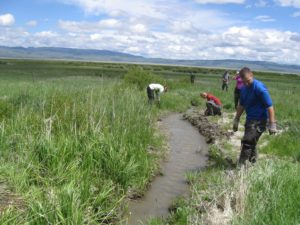On our eighth day, the group met with Kyle Cutting at Red Rock Lake National Wildlife Refuge to  discuss efforts being made to help restore a population of Arctic Grayling. This population uses Amelia Creek and Odell Creek among many others for seasonal spawning sites and year-round use. Climate change, irrigation, and introduced fish species reduce the fitness of Grayling. The group spent all week reading articles and talking about the issues surrounding the fish, and finally, we get to do something about it.
discuss efforts being made to help restore a population of Arctic Grayling. This population uses Amelia Creek and Odell Creek among many others for seasonal spawning sites and year-round use. Climate change, irrigation, and introduced fish species reduce the fitness of Grayling. The group spent all week reading articles and talking about the issues surrounding the fish, and finally, we get to do something about it.
As we walked up to Amelia Creek I couldn’t contain my “Are you kidding me” comment. How was this pitiful creek supposed to support a decently sized fish? The creek was about one foot wide and maybe a foot deep at the best of times. Some areas were only a few inches deep. I could walk though a good section of the creek without getting my ankles wet. Most of the creek was exposed to the sunlight and would have temperatures too high to support egg growth.
The instructions for our restoration project were surprisingly simple. Some people were given shovels to help widen and deepen the stream. They took sediment and relocated it to help cut off diverging streams. Others were given branch cutters to trim and replant native willow branches. Who knew you could cut and replant branches and have them grow? Some of the trees we took branches from were a year or two old.
I worked with a group of about five others on a particular section of the creek. We walked foot-by-foot digging and removing sediment from the bottom and sides of the creek. As soon as we started, the water from upstream was running muddy from the other workers. It was hard to remove some sections as the deep-rooted plants helped keep the sediment together. Hopefully new plants can regrow and help prevent stream erosion.
The results were seen immediately, but after about an hour and some elbow grease, we could really see the creek health improving. We were able to take dirt and rocks from the bottom of the creek and use it to direct the water and prevent overflow to other areas. We stopped working after about an hour to break for lunch. A few minutes after stopping, the water was running clear again and we could really see the improvement. The creek was deeper, wider, and didn’t have other streams diverging from the main creek.
I really wished we could have stayed there longer. It was a wonderful feeling to know that we were able to make such a difference. We spent the previous week reading and talking about the Grayling. Now we finally had a chance to make a difference. Before this project I had no experience with restoration projects, but now I’m addicted. If I lived in the area, I would have definitely gone back until the project was done. It’s amazing how quickly we were able to make those sections of the creek habitable again. I hope to find more restoration projects closer to where I live. It’s just an incredible that a creek I once scoffed at is now functional and able to support a struggling species.